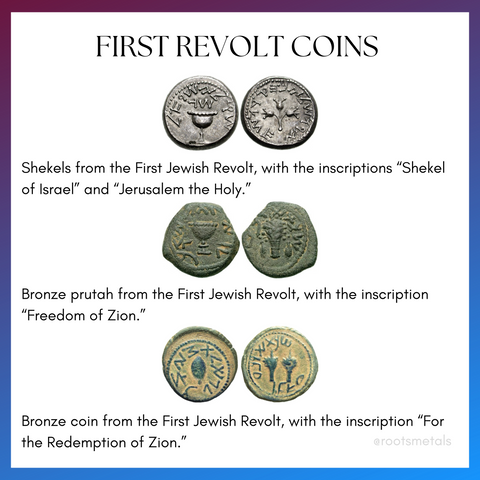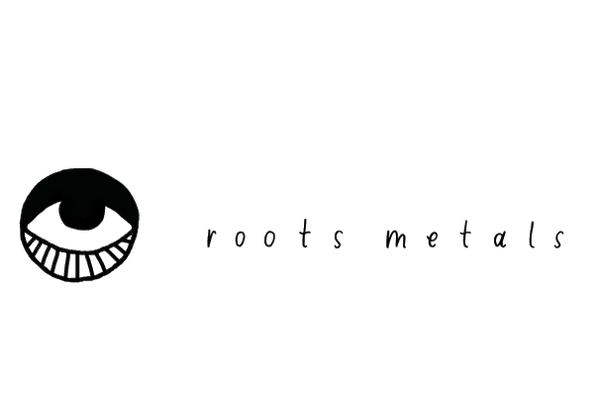
FAMOUS PALESTINE COIN
I’m sure you’ve seen this coin floating around Israel-Palestine online discourse. This is a British coin from the period of the British Mandate of Palestine (1923-1947). Anti-Zionists will often point to this coin to prove Palestinian Indigeneity and their assertion that Israel is a recent, colonial invention.
There are a couple of glaring problems with this interpretation, though: (1) to use a British coin as proof of Indigeneity is absurd, considering the British Empire was indisputably a colonial entity in Israel/Palestine, and (2) the coin includes the acronym “Aleph Yud” in Hebrew, meaning “Eretz Israel,” or the Land of Israel (in other words, the coin itself refers to the land as both Palestine and the Land of Israel).
Coincidentally, however, coins have long been representative of Jewish Indigenous resistance in the Land of Israel, nearly 2000 years prior to the period of the British Mandate.

FIRST JEWISH REVOLT
Between 66-73 CE, the Jews of the Land of Israel, then the Roman province of Judea, revolted against the Roman occupation of their land. The reasons for the revolt were multifold: heavy taxation, Jewish-Roman religious tensions, political turmoil, Jewish dissatisfaction with Roman rule, class divides among the Jewish population (class divides that had been instigated by the Romans themselves), and, of course, a Jewish desire for independence and sovereignty from the Roman Empire.
Early in the revolt, the Jewish revolutionaries captured Jerusalem, which gave them access to the Temple and the Temple treasury. As such, they minted their own two silver coins: a shekel and a half shekel (for those unaware, the currency used in Israel today is called the new Israeli shekel). On one side, they feature a chalice with the year of the revolt and an inscription: “Shekel of Israel.” On the other side, there are three budding pomegranates and the inscription “Jerusalem the Holy.”
During the second and third years of the revolt, the rebels minted bronze prutahs. They feature an amphora, with the date and an inscription: “Freedom of Zion.”
On the fourth year of the revolt, as silver supplies ran low, three kinds of bronze coins were minted. The smallest feature a chalice, symbols representing the harvest festival of Sukkot, and the inscription “For the Redemption of Zion.” The medium sized coins have the same inscriptions, with a large estrog on one side and two lulavs on the other. Finally, the largest coins feature a lulav and an etrog, with a palm tree and baskets on the other side.
While earlier coins existed in the region, minted by whichever empire controlled the land at any given point, the First Jewish Revolt coins are the first Jewish coins ever minted.
FIRST REVOLT COINS

BAR KOKHBA REVOLT
Following the unsuccessful First Jewish Revolt, the Jews in Roman Judea once again revolted against the Roman Empire between 132-136 CE, under the leadership of Simon Bar Kokhba, in an uprising known as the Bar Kokhba Revolt.
Because the Temple had been destroyed in the midst of the First Jewish Revolt, in 70 CE, there was no longer a Temple treasury in which to mint coins. However, the Jewish rebels still wanted to create their own coins as a sign of sovereignty from the rule of the Roman Empire. As such, the rebels had to get creative.
To make their coins, they collected all of the foreign silver and bronze circulating in Judea, coming from the regions of Rome, Syria, Phoenicia, and more. They then filed off the original designs, re-stamping the coins with Jewish symbols and Hebrew inscriptions. In many cases, you can still see the remnants of the original designs in coins from the time period.
The Bar Kokhba Revolt coins include three different types of currency: (1) the silver sela, (2) the silver denarius (“zus” in Hebrew), and (3) large bronze coins, which were large enough to include the inscription: “Simon Prince of Israel.”
Like the coins of the First Jewish Revolt, the Bar Kokhba Revolt coins depicted agricultural Israelite symbols associated with the Sukkot harvest festival. Some rare coins include grape vines and a seven-branched palm tree, which could allude to the Temple Menorah, which was considered too sacred to depict. The inscriptions “Year One of the Redemption of Israel,” “Year Two of the Redemption of Israel,” and so forth, corresponding to the year of the Revolt, can be seen on the coins. Others were engraved with the phrase “For the Freedom of Jerusalem.”
BAR KOKHBA REVOLT COINS

FIRST REVOLT: OUTCOME
In 70 CE, the Romans circled Jerusalem but were unable to breach its walls, so they set up camp around the city and began building trenches around the circumference of the walls. Anyone caught in the trenches attempting to flee the city was crucified; at one point, the Romans were crucifying 500 Jews a day.
For seven months, the Romans sieged Jerusalem, until the summer of 70 CE, when they were finally able to breach the city walls. Records of the time indicate that all of the besieged Jews — men, women, even children — fought to the death, preferring to die for the cause of sovereignty over survival if survival meant that the Romans would exile them from their homeland. Ultimately, the Romans ransacked and burnt the entire city. The Second Temple was destroyed once again on July 29 or 30 of 70 CE, which also fell on the 9th of the Hebrew month of Av.
The Romans pillaged the temple, taking with them its spoils to Rome.
The Revolt finally came to an end when the Romans infamously sieged the fortress of Masada in 73 to 74 CE.
According to the Jewish historian Josephus, over a million Jews were massacred in the First Revolt, though the number is disputed by some historians today. About 100,000 Jews were enslaved and some 50,000 Jewish rebels were slaughtered.
SIEGE OF MASADA
The First Jewish Revolt was finally crushed when the Romans besieged the fortress of Masada between 73-74 CE, located in the Judean Desert in modern-day Israel.
According to the traditional narrative of the account, told by the Jewish historian (and Roman captive) Josephus, following a two to three month siege, the Romans were finally able to breach the fortress. Rather than falling captive to the Romans, some 960 Jews, including women and children, committed mass suicide; as Judaism prohibits suicide, Josephus claimed that the defenders killed each other down to the last man, who was the only one to take his own life. However, modern archeological evidence suggests that the Jewish defenders did not take their own lives, but rather, were massacred by the Romans.
First Jewish Revolt coins are often dubbed “Masada coins” in remembrance of this tragedy.

HADRIANIC GENOCIDE
Like the First Jewish Revolt, the Bar Kokhba Revolt was crushed in 135 CE, with disastrous results for the Jewish population of Judea. The final major battle took place in Bethar, though small skirmishes continued in the Judean Desert into 136 CE.
In an retaliatory act of genocide, the Roman emperor Hadrian massacred some 600,000 Jews and razed over 1000 towns and villages. Some ~400,000 more Jews died due to famine and disease. The Hadrianic Genocide was the biggest calamity to befall the Jewish People until the Holocaust nearly 2000 years later.
Following the Jewish defeat, Hadrian dissolved the Roman province of Judea and established another province, Syria-Palestina in its stead. Most historians agree that he did so to erase the Jewish ties to the land. The Romans established a colony, Aelia Capitolina, on the ruins of Jerusalem. Jews were banned from the city, only permitted to enter on the 9th of the Hebrew month of Av, to commemorate the destruction of the Temples.
In the years after the revolt until his death in 138 CE, Hadrian continued to heavily discriminate against Syria-Palestina’s Jewish population. Many Jews were killed, even after the end of the revolt. Torah study, circumcision, the observance of Shabbat, meeting in synagogues, and other Jewish ritual practices were prohibited. Jewish courts were abolished as well, completely stripping Jews of any autonomy in our ancestral land (save for a brief period in the seventh century) until 1948.
For a full bibliography of my sources, please head over to my Patreon.
